Marin Courthouse
I’ve never really liked these things that Frank Lloyd Wright did
that have all the circles in them. It’s pretty in an abstract sort of
way, but I wouldn’t want to live there:
One of the things that Christopher Alexander says about all this is that the
architect allowed an abstract image or idea take precedence over the life
of the site, and the people that were to be using it. In Wright’s case, he was
at war with “The Box” at the time, and using circles seemed like a good idea
at the time. It just doesn’t look like a friendly place to sit around in and read
a book.


the pic above looks more like roman aqueducts. i don’t think that wright is really the right master for your particular setting…just my opinion. i think with the size you are working with and everything i’ve written, the way to go is minimalism (i am biased though because it’s my fav). i am envisioning a little bit more of a louis kahn type look to what you are trying to achieve. don’t be afraid of throwing a little calculus…get some good and harmonic curves in there. especially over the top. another nice touch would be making the jacuzzi on the deck just big enough on the deck that you could give it some negative edging which with a zion like landscape over the side, has a lot of beautiful potential. if you were to really make the deck the way you have it on the previous drawings, you should make a jacuzzi the centerpiece and right in the middle. another thing to not forget is that you are going to need a lot of overhang for the deck or else no one will be able to sit out there for more than about 10 minutes at a time…especially fair skinned folks like myself and jean.
I imagine that the deck will have a substantial overhang. Have also
been considering putting in some of those water-misting devices on
the edge of the roof to cool things down a bit more.
Regarding Louis Kahn: there is nothing wrong with minimalism per se,
but his work seems a bit conceptual, influenced by what C. Alexander calls the
“thrall of the image”, meaning that the architect is allowing an image
or concept to overtake the organic growth of the building
from the ground, and the lives of its inhabitants.